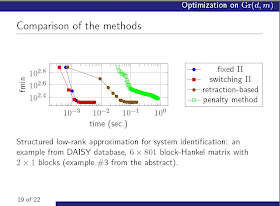Since the last Nuit Blanche in Review (July 2013) , we featured one implementation:
we also focused on several subjects
- Sampling and high-dimensional convex geometry
- Combinatorial Group Testing Magic Trick
- Optical frequency comb interference profilometry using compressive sensing
- Saturday Morning Videos: Gingko, Videos of the 2013 Summer meetings
- Cleaning Up Toxic Waste Removing Nefarious Contributions to Recommendation Systens
- Accurate Decoding of Pooled Sequenced Data Using Compressed Sensing
- GLIMPSE: Accurate 3D weak lensing reconstructions using sparsity
- Compressive Multiplexing of Correlated Signals
- Is Somebody Watching Your Facebook Newsfeed?
- Convex Optimization Approaches for Blind Sensor Calibration using Sparsity /A Conjugate Gradient Algorithm for Blind Senor Calibration in Sparse Recovery
- Coded Acquisition of High Frame Rate Video
- Compressive Sensing in Control Theory
- Frequency Multiplexed Magnetometry via Compressive Sensing / Compressing measurements in quantum dynamic parameter estimation
We mentioned two ideas (more on those later)
and featured a slew of blog entries of interest:
We reported and featured the videos and slides of the meetings of importance in the field this Summer:
Credit: NASA/ESA
Join the CompressiveSensing subreddit or the Google+ Community and post there !
 Liked this entry ? subscribe to Nuit Blanche's feed, there's more where that came from. You can also subscribe to Nuit Blanche by Email, explore the Big Picture in Compressive Sensing or the Matrix Factorization Jungle and join the conversations on compressive sensing, advanced matrix factorization and calibration issues on Linkedin.
Liked this entry ? subscribe to Nuit Blanche's feed, there's more where that came from. You can also subscribe to Nuit Blanche by Email, explore the Big Picture in Compressive Sensing or the Matrix Factorization Jungle and join the conversations on compressive sensing, advanced matrix factorization and calibration issues on Linkedin.
- Meetings: A Summer Tour
- Slides: SPARC 2013, Coding, Complexity, and Sparsity Workshop
- Videos: ROKS 2013, International Workshop on Advances in Regularization, Optimization, Kernel Methods and Support Vector Machines
- COLT 2013 Videos
- SAHD: Gigapixel! - Michael Gehm
- SAHD: Recovering a High Dimensional Manifold from Snapshots - Ron DeVore
- SAHD: Dynamic L1 Reconstruction - Justin Romberg
- SAHD; Living on the edge: A geometric theory of phase transitions in convex optimization - Joel Tropp
- SAHD: Going off the Grid - Benjamin Recht
- SAHD: Compressive Saliency Sensing - Jarvis Haupt
- SAHD: Multiscale bi-Harmonic Analysis of Digital Data Bases and Earth moving distances - Raphy Coifman
and finally we had several videos around the genomics subject are:
- Overview of the evolution of genome technology - Richard Wilson
- From Correlation to Causation in Human Microbiome Studies - Rob Knight
- Saturday Morning Videos: Human Microbiome Science: Vision for the Future
- Saturday Morning Video: A year of curiosity
- Saturday Morning Videos: Gingko, Videos of the 2013 Summer meetings
Credit: NASA/ESA










